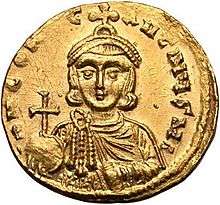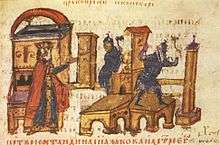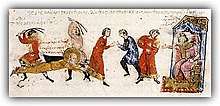Constantine V
| Constantine V | |
|---|---|
| Emperor of the Romans | |
 Constantine V - gold solidus | |
| Emperor of the Byzantine Empire | |
| Reign | 18 June 741–14 September 775 |
| Predecessor | Leo III the Isaurian |
| Successor | Leo IV the Khazar |
| Born |
July 718 Constantinople |
| Died | 14 September 775 (aged 57) |
| Wives | |
| Issue |
Leo IV Nikephoros, Caesar, Christopher, Caesar Niketas, Nobelissimos, Eudokimos, Nobelissimos, Anthimos, Nobelissimos, Anthousa (Saint Anthousa) |
| Dynasty | Isaurian dynasty |
| Father | Leo III the Isaurian |
| Mother | Maria |
| Isaurian or Syrian dynasty | |||
| Chronology | |||
| Leo III | 717–741 | ||
| with Constantine V as co-emperor, 720–751 | |||
| Constantine V | 741–775 | ||
| with Leo IV as co-emperor, 751–775 | |||
| Artabasdos' usurpation | 741–743 | ||
| Leo IV | 775–780 | ||
| with Constantine VI as co-emperor, 776–780 | |||
| Constantine VI | 780–797 | ||
| under Irene as regent, 780–790, and with her as co-regent, 792–797 | |||
| Irene as empress regnant | 797–802 | ||
| Succession | |||
| Preceded by Twenty Years' Anarchy |
Followed by Nikephorian dynasty | ||
Constantine V (Greek: Κωνσταντῖνος Ε΄; July, 718 AD – September 14, 775 AD), denigrated by his enemies as Kopronymos or Copronymus, meaning the dung-named, was Byzantine emperor from 741 to 775. His reign saw a consolidation of Byzantine security from external threats. An able military leader, Constantine was able to take advantage of Muslim disunity to make limited offensives on the Arab frontier. Secure in the East, he undertook repeated campaigns against the Bulgars in the Balkans. His military activity, and policy of settling Christian populations from the Arab frontier in Thrace, made Byzantium's hold on its Balkan territories more secure. His fervent support of Iconoclasm led to his vilification by later Byzantine historians and writers.
Early life
Constantine was born in Constantinople, the son and successor of Emperor Leo III and Maria. In August 720 he was associated on the throne by his father, who had him marry Tzitzak, daughter of the Khazar khagan Bihar. His new bride was baptized as Irene (Eirēnē, "peace") in 732. Constantine V succeeded his father as sole emperor on 18 June 741.[1]
Civil war against Artabasdos
In June 742, while Constantine was crossing Asia Minor to campaign on the eastern frontier against the Umayyad Caliphate under Hisham ibn Abd al-Malik, his brother-in-law Artabasdos, husband of his older sister, Anna, rebelled. Artabasdos was the stratēgos of the Armeniac theme. Constantine sought refuge in Amorion, where he was enthusiastically welcomed, while Artabasdos advanced on Constantinople and, with the support of Theophanes Monutes (Constantine's regent) and the patriarch Anastasius, was accepted as Emperor. Constantine received the support of the Anatolic and Thracesian themes; Artabasdos secured the support of the themes of Thrace and Opsikion, in addition to his own Armeniac soldiers.[2][3]
The rival emperors bided their time making military preparations. Artabasdos marched against Constantine at Sardis in May 743 but was defeated. Three months later Constantine defeated Artabasdos' son Niketas at Modrina and headed for Constantinople. In early November Constantine was admitted into the capital, following a siege, and immediately turned on his opponents, having them blinded or executed. Patriarch Anastasius was paraded on the back of an ass around the hippodrome to the jeers of the Constantinopolitan mob, though he was subsequently allowed to stay in office.[4][5]
The usurpation of Artabasdos was connected with restoring the veneration of images, leading Constantine to become perhaps an even more fervent iconoclast than his father. Constantine's avowed enemies over this extremely emotional issue, the iconodules, applied to him the derogatory epithet Kopronymos ("dung-named", from kopros, meaning "feces" or "animal dung", and onoma, "name"). Using this obscene name, they spread the rumour that as an infant he had defecated in his baptismal font, or on the imperial purple cloth with which he was swaddled.[6]
Political regime
Constantine was assiduous in courting popularity with the populace of Constantinople, consciously using the hippodrome and the ever-popular chariot races to mobilize and influence the people. The hippodrome became the scene of rituals of humiliation for war captives and political enemies, in which the mob took active delight. Constantine's sources of support were the people and the army, and he used them against his iconodule opponents in the monasteries and in the bureaucracy of the capital. Iconoclasm was not purely an imperial heresy, it had considerable popular support, some of Constantine's actions against the iconodules may have been motivated by a desire to retain the approval of the people. Bureaucrats and monks were the writers of history, and the later triumph of the iconodule party ensured the vilification of Constantine V's memory.[7]
Administration
Constantine V carried forward the administrative and fiscal reforms instigated by his father Leo III. The military governors (strategi) were powerful figures and the extent of their provinces and resources were springboards for rebellion. Constantine reduced the size of the theme (province) nearest to the capital, the Opsikion theme, dividing from it the Bucellarian and perhaps the Optimaton themes.[8]
Constantine was responsible for the creation of a small central army of fully professional soldiers, the imperial tagmata (literally: 'the regiments'). This force was designed to form the core of field armies and was composed of better trained, paid and equipped soldiers than were found in the provincial themata units, whose troops were part-time soldier-farmers. Being largely based at the capital, the tagmata were under the immediate control of the emperor and were free of the regional loyalties that were behind many military rebellions.[9]
The fiscal administration of Constantine V was highly competent. This drew from his enemies accusations of being a merciless and rapacious extractor of taxes and oppressor of the rural peasants. However, the empire was prosperous and Constantine left a very full treasury for his successor. Constantine's court was opulent, with splendid buildings and he consciously promoted the patronage of secular art to replace the religious art that he removed.[10]
Constantine's support of iconoclasm


Constantine's position on Iconoclasm was clear: "He cannot be depicted. For what is depicted in one person, and he who circumscribes that person has plainly circumscribed the divine nature which is incapable of being circumscribed."[11] The emperor was personally active in the theological debate, writing no less than thirteen treatises, two of which survive in fragmentary form.[12] In February 754 Constantine convened a synod at Hieria, which was attended entirely by Iconoclast bishops. The council approved of Constantine's religious policy and secured the election of a new Iconoclast patriarch, but refused to follow in all of Constantine's views. The council confirmed the status of Mary as Theotokos, or Mother of God, reinforced the use of the terms "saint" and "holy" as meet, and condemned the desecration, burning, or looting of churches in the quest to quench Iconophiles.[13]
The synod was followed by a campaign to remove images from the walls of churches and to purge the court and bureaucracy of Iconodules. Since monasteries tended to be strongholds of Iconophile sentiment, Constantine specifically targeted the monks, pairing them off and forcing them to marry nuns in the hippodrome and expropriating monastic property for the benefit of the state or the army. The repressions against the monks (culminating in 766) were largely led by the Emperor's general Michael Lachanodrakon, who threatened resistant monks with blinding and exile. An iconodule abbot, Stephen Neos, was brutally lynched by a mob at the behest of the authorities. As a result, many monks fled to southern Italy and Sicily.[14] The implacable resistance of iconodule monks and their supporters led to their propaganda reaching those close to the emperor. Constantine reacted with savagery, in 765 eighteen high dignitaries were paraded in the hippodrome charged with treason, they were variously executed, blinded or exiled. The patriarch Constantine was implicated and deposed from office, the following year he was tortured and finally beheaded.[15]
By the end of Constantine's reign, Iconoclasm had gone as far as to brand relics and prayers to the saints as heretical. Ultimately, iconophiles considered his death a divine punishment. In the 9th century his remains were removed from the imperial sepulchre in the Church of the Holy Apostles.[16]
Campaigns against the Arabs and Bulgaria
.png)
In 746, profiting by the unstable conditions in the Umayyad Caliphate, which was falling apart under Marwan II, Constantine V invaded Syria and captured Germanikeia (modern Maraş, his father's birthplace), and recaptured Cyprus. He organised the resettlement of part of the local Christian population to Imperial territory in Thrace. In 747 his fleet destroyed the Arab fleet off Cyprus. In 751 he led an invasion into the new Abbasid Caliphate under As-Saffah. Constantine captured Theodosioupolis and Melitene (Malatya) and again resettled some of the population in the Balkans. These campaigns failed to secure any concrete gains (apart from additional population employed to strengthen another frontier), but it is important to note that under Constantine V the Empire had gone on the offensive. His military reputation was such that, in 757, the mere rumour of his presence caused an Arab army to retreat.[17][18]
Meanwhile, with Constantine occupied, and indifferent to the continuance of imperial influence in the West, Lombard king Aistulf captured Ravenna in 755, ending over two centuries of Byzantine rule in central Italy.[19][20]
The successes in the east made it possible to pursue an aggressive policy in the Balkans. With the resettlement of Christian populations from the East into Thrace, Constantine V aimed to enhance the prosperity and defence of the area> Allied to an active re-fortification of the border, this caused concern to the Empire's northern neighbour, Bulgaria, leading the two states to clash in 755. Kormisosh of Bulgaria raided as far as the Anastasian Wall but was defeated in battle by Constantine V, who inaugurated a long series of nine successful campaigns against the Bulgarians in the next year, scoring a victory over Kormisosh's successor Vinekh at Marcellae.[21]
Three years later, Constantine was defeated in the battle of the Rishki Pass, but the Bulgarians did not exploit their success. In 763, he sailed to Anchialus with 800 ships carrying 9,600 cavalry and some infantry. Constantine's victories, including that at Anchialus in 763, caused considerable instability in Bulgaria, where six monarchs lost their crowns on account of their failures.[22]
In 762 Constantine campaigned against the Slav tribes in Thrace and Macedonia, deporting some tribes to the Opsician theme in Anatolia, though some voluntarily requested relocation away from the troubled Bulgarian border region.[23][24]
In 775, Constantine was persuaded to reveal to the Bulgarian ruler Telerig the identities of his agents in Bulgaria, and they were promptly eliminated. Constantine thus began preparations for a new campaign against the Bulgarians, during which he died, on September 14, 775. Though Constantine was unable to destroy the Bulgar state, or impose a lasting peace, he restored imperial prestige in the Balkans.[25][26]
Assessment and legacy
Constantine V was an able ruler, he continued the reforms, fiscal, administrative and military, of his father. He was also a successful general, not only consolidating the empire's borders, but actively campaigning beyond those borders, both East and West. In concentrating on the security of the empire's core territories he tacitly abandoned some peripheral regions, notably in Italy, which were lost. However, the hostile reaction of the Roman Church and the Italian people to iconoclasm had probably doomed imperial influence in central Italy, regardless of any possible military intervention. Due to his espousal of iconoclasm Constantine was damned in the eyes of contemporary iconodule writers and subsequent generations of Orthodox historians. Typical of this demonisation are the words of Theophanes the Confessor concerning Constantine: "a monster athirst for blood", "a ferocious beast", "unclean and bloodstained magician taking pleasure in envoking demons", " a precursor of Antichrist". However, to his army and people he was "the victorious and prophetic Emperor", though his actions show him to have been autocratic and sometimes harsh.[27][28]
Family
By his first wife, Tzitzak ("Irene of Khazaria"), Constantine V had one son:
- Leo IV, who succeeded as emperor.
By his second wife, Maria, Constantine V is not known to have had children.
By his third wife, Eudokia, Constantine V had five sons and a daughter:
- Christopher, Caesar
- Nikephoros, Caesar
- Niketas, Nobelissimos
- Eudokimos, Nobelissimos
- Anthimos, Nobelissimos
- Anthousa
See also
References
- ↑ Ostrogorsky, p. 165
- ↑ Bury, p. 10
- ↑ Ostrogorsky, p. 165
- ↑ Bury, p. 10
- ↑ Ostrogorsky, p. 166
- ↑ Bury, p. 9
- ↑ Angold, Ch. 5, 'Constantine V', paragraph 7
- ↑ Bury, p. 3
- ↑ Haldon, p. 78
- ↑ Bury, p. 11
- ↑ Nikephoros, Antiherreticus I, PG 100, 301C; trans. Bryer & Herrin
- ↑ Ostrogorsky, p. 171
- ↑ Ostrogorsky, pp. 171-173
- ↑ Ostrogorsky, pp. 173-175
- ↑ Bury, p. 14
- ↑ Ostrogorsky, p. 175
- ↑ Bury, p. 10
- ↑ Ostrogorsky, p. 167
- ↑ Moffat 2017, p. 55.
- ↑ Ostrogorsky, pp. 169-170
- ↑ Bury, p. 11
- ↑ Bury, p. 11
- ↑ Bury, p. 10
- ↑ Ostrogorsky, p. 168
- ↑ Bury, p. 11
- ↑ Ostrogorsky, p. 169
- ↑ Bury, pp. 9-10
- ↑ Ostrogorsky, p. 167
Sources
- Angold, M. (2012) Byzantium: The Bridge from Antiquity to the Middle Ages, Hachette, UK
- Bury, J.B. (1923) The Cambridge Medieval History, Vol. 4: The Eastern Roman Empire, Cambridge University Press.
- Haldon, John F. (1999). Warfare, state and society in the Byzantine world, 565–1204. Routledge. ISBN 1-85728-494-1.
- Moffat, Ann (2017). "The Orient Express:Abbot John's Rapid trip from Constantinople to Ravenna c. AD 700". In Brown, Amelia Robertson; Neil, Bronwen. Byzantine Culture in Translation. Brill.
- Ostrogorsky, G. (1980) History of the Byzantine State, Basil Blackwell, Oxford
Literature
- The Oxford Dictionary of Byzantium, Oxford University Press, 1991.
External links
![]()
Constantine V Born: 718 Died: 14 September 775 | ||
| Regnal titles | ||
|---|---|---|
| Preceded by Leo III |
Byzantine Emperor 18 June 741–14 September 775 |
Succeeded by Leo IV |